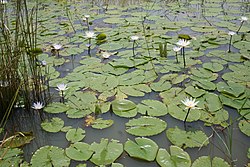| Nymphaea micrantha | |
|---|---|
 | |
| Scientific classification | |
| Kingdom: | Plantae |
| Clade: | Tracheophytes |
| Clade: | Angiosperms |
| Order: | Nymphaeales |
| Family: | Nymphaeaceae |
| Genus: | Nymphaea |
| Subgenus: | Nymphaea subg. Brachyceras |
| Species: | N. micrantha |
| Binomial name | |
| Nymphaea micrantha | |
| Synonyms [3] | |
| |
Nymphaea micrantha is a water lily belonging to the genus Nymphaea . It is native to the tropics of West Africa.
Contents
- Description
- Reproduction
- Vegetative reproduction
- Cytology
- Taxonomy
- Publication
- Natural hybridisation
- Etymology
- Uses
- Food source
- References
- External links



